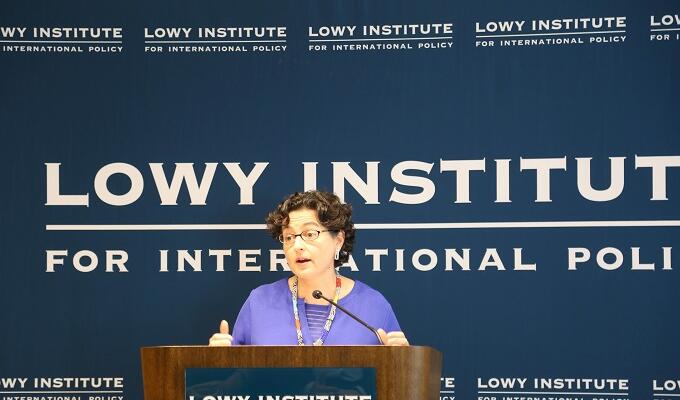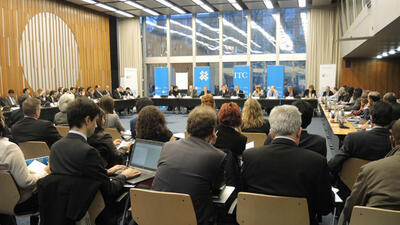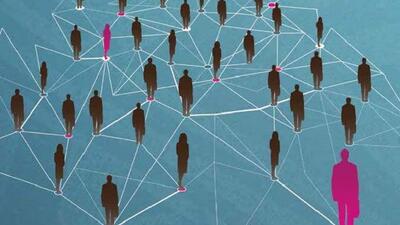

Women’s economic empowerment and how we can help
Sydney, Australia
6 April, 2016
Ladies and Gentlemen,
Good afternoon. I’m delighted to be back here in Sydney and at the Lowy Institute. Before we get started, let me thank our hosts for their important work. To get to good outcomes in our increasingly complex international system, good policy ideas are more important than ever. And think tanks – the best ones, at least – are entrepreneurs of ideas.
Today we’re here to talk about an idea that is incredibly powerful, but also incredibly underutilised. I’m talking about women’s economic empowerment.
Think about the current conversation about the global economy. ‘Secular stagnation’, ‘new normal’, ‘new mediocre’: each new description more dismal than the last.
Yet we waste women’s economic potential every day, on a scale that is staggering.
Now Australia is better than most on this front. In fact, tomorrow I’ll be hearing all about the international successes of this country’s dynamic women-led companies at the Women in Global Business event in Canberra. But according to the World Economic Forum’s Global Gender Gap report for 2015, although Australia rates highly on education and the number of women professional workers, it ranks only 63rd when it comes to equal pay for equal work. So if some of you here happen to be responsible for payroll decisions and are wondering how you can help – that might be one place to look.
McKinsey recently estimated that if women around the world participated in the economy on equal footing to men, with equal wages and participation in high-productivity parts of the labour force, global output would be $28 trillion higher by 2025. That’d be like adding a new US and China to the world economy. Even a more modest scenario, where countries match regional best practice, would add $12tn to the global economy. The IMF thinks that eliminating barriers to employment for girls and women could raise labour productivity by as much as 25% in some countries.
Goodbye, secular stagnation and mediocrity. Hello, equality and opportunity.
Empowering women to become economic actors of change is at the heart of what we do at the International Trade Centre. ITC is a joint agency of the United Nations and the World Trade Organization, founded in 1964, with a mandate to help small and medium-sized enterprises in developing countries connect to international markets. We focus on SMEs because they employ the vast majority of people. We focus on trade because businesses that import or export, or sell to firms that do, tend to be more productive, grow faster, and generate higher-quality, better-paying jobs. We combine the goals of our two parent organisations: expanding access to trade opportunities is our means toward achieving sustainable development.
Let me give you an example of what this looks like in practice. In Burkina Faso and Mali, our Ethical Fashion Initiative has connected the skills of hundreds of workers – 99% of them women – to the top of the international fashion market. The result: brands like Vivienne Westwood, Japan’s United Arrows, and Italy’s Stella Jean are selling cotton prints spun, woven and dyed in safe working by women who are paid a decent wage.
This didn’t happen overnight. The project team worked with the micro-scale producers to help them upgrade product quality, raise labour standards, build connections to the eventual buyers. It engaged with government agencies to identify and smooth potential trade obstacles, enabling production and income flows to continue through the region’s political unrest. The model works. The Ethical Fashion Initiative’s oldest hub, which started in one of Nairobi’s poorest slums, is now fully commercially viable. In fact, a group of private investors took it over last year.
Why connecting women-owned SMEs to trade matters
Today, in many places the distributional aspects of markets and trade have become hot-button political issues. While the ‘lucky country’ might be something of an exception, perceptions are widespread that trade’s benefits have not been shared equally. SMEs are a big part of making sure that the gains from trade are more equitably distributed. So, too, are women. That’s why we’re convinced that connecting women-owned SMEs to world markets is more important than ever.
Globally, three quarters of working age men are in the labour force, compared to only half of working age women. As we’ve seen, the macroeconomic consequences of moving upwards towards gender parity would be enormous. It matters at the national level, too. The Oxford academic Lisa Scott has demonstrated that countries that provide greater economic opportunities for women tend to rank higher on measures of national competitiveness. This is at once significant and unsurprising: after all, no team can leave half its talent on the bench and expect to win.
The consequences of women’s economic empowerment are no less dramatic at the household level. When women are paid for their work, and have control over how the money gets spent, they invest much more of their income than men do in their families’ education and health. Literate fathers often have illiterate children. Literate mothers almost never do. When women have access to education and employment the effects last for generations.
Women’s empowerment also makes good business sense, plain and simple. Greater gender diversity in senior management coincides with higher profits and better stock market valuations, Credit Suisse concluded after studying 3000 global companies.
Other research shows that firms with more women in senior roles are more effective at making the most of employee talent. In spite of all this, in the Fortune 500, there are more CEOs named John than there are women CEOs.
I want to emphasise that the gains aren’t just about big corporations. Emerging firm-level evidence from the United States suggests that the exporter premium – the pay premium at exporting firms over non-exporters – is higher for women-owned businesses than for those owned by men. But ITC’s own research shows that only one in five of exporting firms is owned by women.
ITC works in multiple ways and at multiple levels to help women connect to international markets as entrepreneurs, traders, and workers. We aim to bring practical solutions, tailored to local needs, but producing results that are replicable in the face of similar challenges elsewhere.
Making information about market opportunities and trade-related procedures accessible and affordable in developing countries naturally benefits all SMEs, irrespective of the gender of who runs them.
But when we work with governments to improve policy, or with business associations and trade promotion organisations to help them do better at helping SMEs connect to international trade investment, or with businesses themselves, there’s much more scope for making sure women are not left on the margins of the economy. Let’s look at some examples from the Pacific region – where Australia is an important supporter of what we do.
In Papua New Guinea, colourful woven bilum bags are used across the country for carrying everything from groceries to babies. The handmade bags and clothing have found growing appeal among high-end international fashion brands. The people who typically weave bilums are overwhelmingly women in rural areas. They routinely face long waits before receiving payment for their craft, and sometimes don’t get paid at all. Last year, ITC worked with bilum-producing cooperatives from around the country to set up the Bilum Export and Promotion Association, a non-profit group that will purchase bilum bags and clothing from around the country for export. Revenues will be channelled back into more predictable incomes for the producers, together with the design, technical, and business skills needed to target higher-end foreign buyers.
After Vanuatu was hit by Cyclone Pam last year, hotel bookings collapsed, taking with them a lot of local demand for higher-value agricultural produce as well as handicrafts. ITC is working to reorient these sectors towards supplying cruise ships, in which demand has been more resilient, and overseas markets. In partnership with a local agricultural college, we have mapped out local producers and trained women farmers, agriculture extension service providers, technicians and transporters, and helped the sector improve packing and packaging. In the handicraft sector, ITC is establishing a Women Exports Association and training women in product quality and export marketing. I’m happy to report that the Queensland Gallery of Modern Art has made an initial order of bags for their shop.
Samoa, meanwhile, has been an early partner in our worldwide efforts to bolster the share of public procurement contracts that go to women-owned businesses from developing countries. The world’s governments spend trillions of dollars every year – more than 10% of GDP for most developing countries, and much more in developed countries - on purchasing the goods and services they need to fulfil their functions. Only a small fraction of these contracts go to women-owned businesses. Some of this imbalance can be rectified with measures as simple as publicising procurement opportunities to women’s business organizations.
Other measures go much further: 5% of all US federal contracts are supposed to go to historically underutilised businesses, a category that includes those ‘owned and controlled’ by women. In Samoa, ITC is working to change policies mindsets within government to accept and encourage women-owned enterprises as potential suppliers. Women entrepreneurs are being coached to make more and better bids for contracts – and indeed to believe that they can win them! We should bear in mind that even the US’s 5% target took some 20 years to achieve.
Women’s economic equality requires an ecosystem of support
Ladies and gentlemen, we have all heard the popular phrase “it takes a village to raise a child.” Well, it takes even more than that to achieve gender economic equality.
This is why, as part of our SheTrades initiative to connect one million women entrepreneurs to markets by 2020, we have launched a Call to Action – one that probably applies to most of the people in this room. The call sets out a framework for companies, governments, and civil society organisations – any stakeholder in development, really – to make specific, measurable pledges that contribute to the goal of integrating women more fully into the global economy.
The Call to Action, which I urge all of you to look up and sign up to, has eight pillars: data collection, analysis and dissemination; trade policy; corporate procurement; public procurement; certification; supply side constraints; financial services; and ownership rights.
How would this play out? Let’s look at the data pillar. Only 41 governments collect sex-disaggregated data about women’s participation in the economy – and it’s hard to improve what you can’t measure. But it’s not just about governments. Businesses need to measure and report on gender gaps. Think tanks, meanwhile, have a responsibility to analyse the barriers facing women in the economy and the global marketplace, and identify how best to remove them. We’ve already seen how public procurement can empower women-owned businesses; private sector corporations can do the same, by sourcing more from women.
Women’s full participation in the economy is held back, in far too many places, by discriminatory laws. In 18 countries the law gives husbands the right to prohibit their wives from working outside the home! Women entrepreneurs in emerging markets are stifled by inadequate and unequal access to banking services and to capital – a gap estimated to total between $260-320 billion per year. Some budding entrepreneurs here in Sydney might feel the same way: in the global tech sector, only a small fraction of venture capital goes to startups led by women.
Women on average have less access to technology and the internet than men do. In 2012, Intel estimated that giving women access to the internet could contribute between $13-18 billion to annual GDP across 144 developing countries.
Technology works the other way, too, though. It can be a useful tool for women’s economic empowerment, by lowering the barriers to doing business. Last year, IT launched a web and mobile app for women entrepreneurs. The app, called SheTrades, lets women-owned businesses showcase their goods and services to prospective buyers.
Not entirely in jest, the head of our women and trade programme calls it ‘Tinder for businesses’. You can download the app from the Google Play store, or check it out at SheTrades.com.
But the enabling environment for gender equality goes beyond apps, and even beyond the eight pillars of the call to action. We need far reaching changes in sociocultural expectations about household duties, caring work, and child-rearing, which currently weigh disproportionately on women, leaving them with less time to invest in paid work, networking, and skills building.
Social policy, for childcare and parental leave, can help shift cultural mores and create more time for working mothers. One of the most powerful examples of this was Norway’s introduction of the ‘father’s quota’ of parental leave in 1993. Before that, only 2% of men took time off work after the birth of a child. Today, more than 90% do. And fathers who take parental leave to bond with their infant children end up doing more diapers, and staying more involved with childcare well beyond infancy. This leaves more time for mothers to do paid work.
Governments may have to experiment with mandatory laws: Japan recently introduced some of the world’s most generous paternity leave provisions in an attempt to boost the low birth rate, but last year only 2.3% of those eligible took it. That said, Japan has in recent years had some success at bringing more women into the workforce, with the result that its labour force is shrinking less quickly than its population.
We also need big changes in the way we think about and divide up unpaid work. According to one estimate, the unpaid work done by women around the world is roughly equivalent to the annual output of China. Of course, a lot of this work simply needs to be done: it might be good for the GDP data if you paid your neighbour to take care of your kids, while they paid you to take care of theirs, but it wouldn’t make much sense.
Unpaid work needs to be properly valued, and properly shared. Men need to step up and share the burden, in the home, in the community, and in the workplace.
And here, Australia has considerable room for improvement. According to OECD data, men in this country spend an average of 2.9 hours per day on unpaid work such as cleaning, cooking and childcare. Women, meanwhile, spend 5.3 hours a day. The good news: you’re doing better than Italy. The bad news: New Zealand is beating you. And even households in my native Spain have a more balanced workload. To the Aussie men here: now you know what you can do to help!
Ladies and gentlemen. Over the past three decades we have seen the world economy transformed by the emergence of billion-strong China and India as full economic actors. The large number of women currently on the margins of the global economy are like a third billion, poised to transform their own prospects – and ours, too. At ITC, we’re trying to contribute to this, directly connecting women-owned businesses to markets and trying to put in place enabling tools and policies. But we can only get there together.
Thank you.








